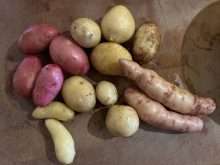Fall is a very busy season for market gardeners Wally Satzewich and Gail Vandersteen harvesting root crops and preparing vegetables for the Saskatoon Farmers’ Market. The Saskatoon couple had a large selection of fresh, chemical-free vegetables, herbs and flowers for sale from the garden plots they manage throughout the city.
Wally and Gail currently ‘farm’ about five backyard garden plots in Saskatoon; two larger plots on the outskirts of the city; three in the town of Pleasantdale, northwest of Saskatoon; and six in Manitoba, where Gail grew up. Plots range in size from 500 to 6,000 square feet. Many of the garden plots are free; others are paid for through ‘stand credit’ whereby the property owners are able to access produce at the market.
Read Also

Gentle treatments for pain in the neck
Heading toward year-end, people unknowingly tense up against the cold and busyness, causing neck pain that can often be treated with appropriate support and gentle mobility, athletic therapist Kathlyn Hossack says.
Gail’s love of gardening began as a four-year-old helping her parents, both avid horticulturalists, tending their large farm garden north of Winnipeg. She didn’t take up gardening again until she met Wally at the farmers’ market in Saskatoon. Together they became urban farmers, growing and selling a variety of fresh produce at the market from late May until late October.
The garden plots outside the city are reserved for root crops such as potatoes, carrots, beets, onions and garlic as well as pumpkins and squash. The city plots are where they grow tomatoes, beans, peas, peppers, cucumbers, rhubarb, sunflowers, and many varieties of lettuce, spinach and other greens that need immediate cooling after harvesting.
“Our home base is in Saskatoon where we have access to a walk-in cooler. That allows us to harvest and clean vegetables several days before market day,” says Gail.
The couple has developed a niche market by adding micro-greens like herbs and radish, sunflower, and broccoli greens to their list, which can be grown every 10 days to two weeks, 365 days of the year under grow lights.
Growing vegetables in an urban setting has proven beneficial; there are fewer insects to contend with, the growing season is slightly longer because the city has a microclimate, they have access to existing water sources, and they are close to market. Garden plots can be acquired at low cost, and because they plant, weed and harvest mostly by hand, there are minimal operating costs. “We use a lot of rain-harvesting techniques, and use city water only when we have to,” says Gail.
All the produce is grown without herbicides or pesticides. “We hand pull weeds before they go to seed. It makes amazing green manure. We use only natural fertilizers — composting and utilizing all the kitchen waste.” They’ve also learned the value of companion planting — planning the garden to take advantage of the fact that some plants repel certain insects; others help each other grow.
In the 1990s Wally began formulating ideas which market gardeners could implement to increase their revenue through the intensive use of urban garden plots, growing high-value crops with low overhead. The ideas were developed into what they now call the SPIN (small plot intensive) farming system. He has teamed up with writer and SPIN farmer Roxanne Christensen in Pennsylvania to produce a guide for prospective urban farmers to set up and launch their businesses. There are currently over 600 SPIN farmers across the U.S., Canada and around the world.
“I see it as a viable farming model in competition with other farming models. I’m focused on how people can make some money for themselves and doing so in an environmentally friendly way,” says Wally. “To me it’s not the money that’s important. It’s the revolution about self-sufficiency.”
“I feel very rich in my life. I enjoy working with the soil, the plants, the sun and the weather — it’s a healthy environment in every sense of the word,” adds Gail.
For more information on SPIN farming go to www.spinfarming.com. †














